Government Regulation of Monopolies
VerifiedAdded on 2020/02/24
|8
|1691
|67
AI Summary
This assignment delves into the crucial role government regulation plays in managing monopolies. It examines why regulating monopolies is necessary, focusing on their tendency to exploit consumers through high prices and poor quality goods due to limited competition. The text highlights various regulatory tools employed by governments, such as price caps, average cost pricing, and rate of return regulations, along with the establishment of regulatory bodies to monitor monopolies. Specific examples of regulatory bodies in Australia are provided to illustrate the practical application of these measures. Ultimately, the assignment emphasizes that government regulation safeguards consumer welfare by ensuring reasonable prices, high-quality products, and market efficiency.
Contribute Materials
Your contribution can guide someone’s learning journey. Share your
documents today.
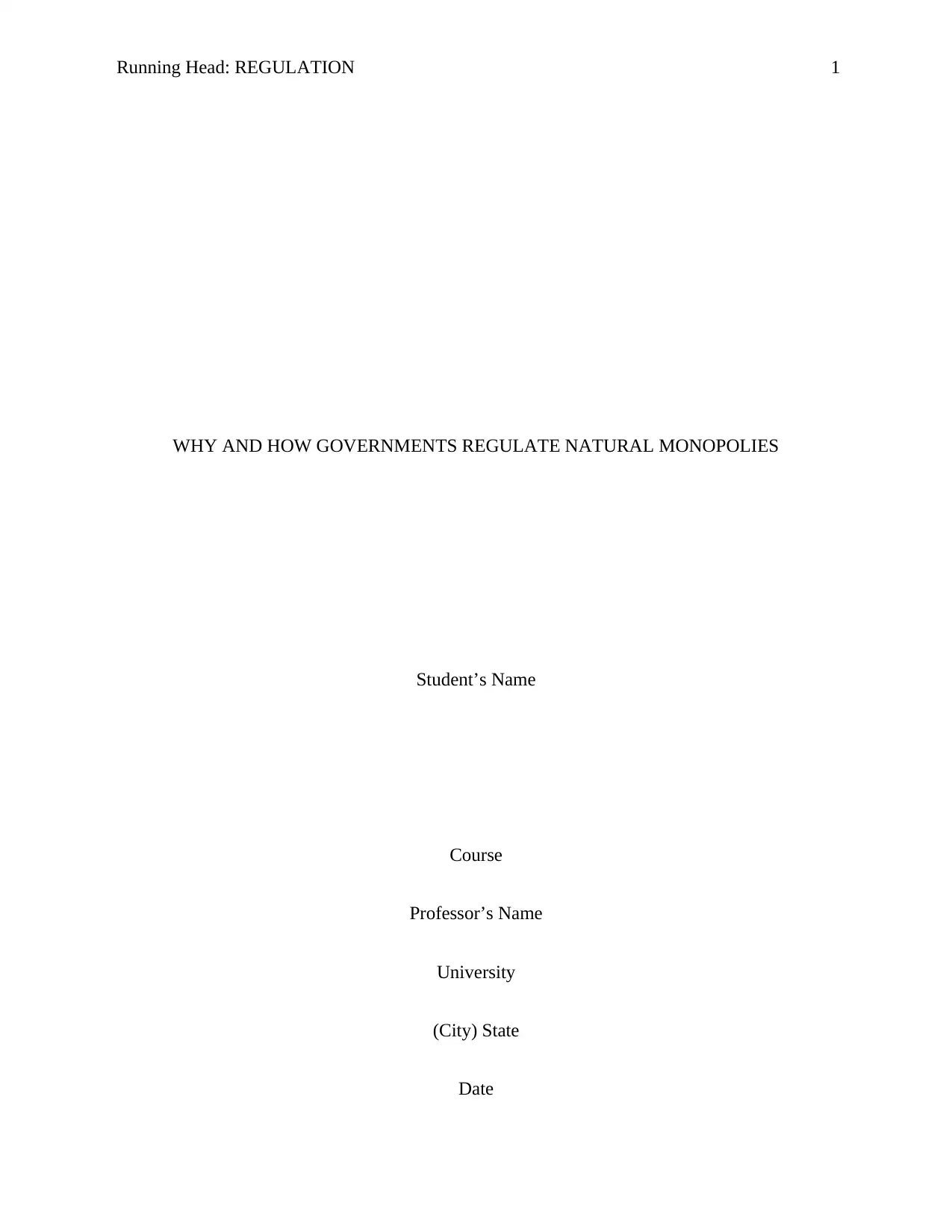
Running Head: REGULATION 1
WHY AND HOW GOVERNMENTS REGULATE NATURAL MONOPOLIES
Student’s Name
Course
Professor’s Name
University
(City) State
Date
WHY AND HOW GOVERNMENTS REGULATE NATURAL MONOPOLIES
Student’s Name
Course
Professor’s Name
University
(City) State
Date
Secure Best Marks with AI Grader
Need help grading? Try our AI Grader for instant feedback on your assignments.
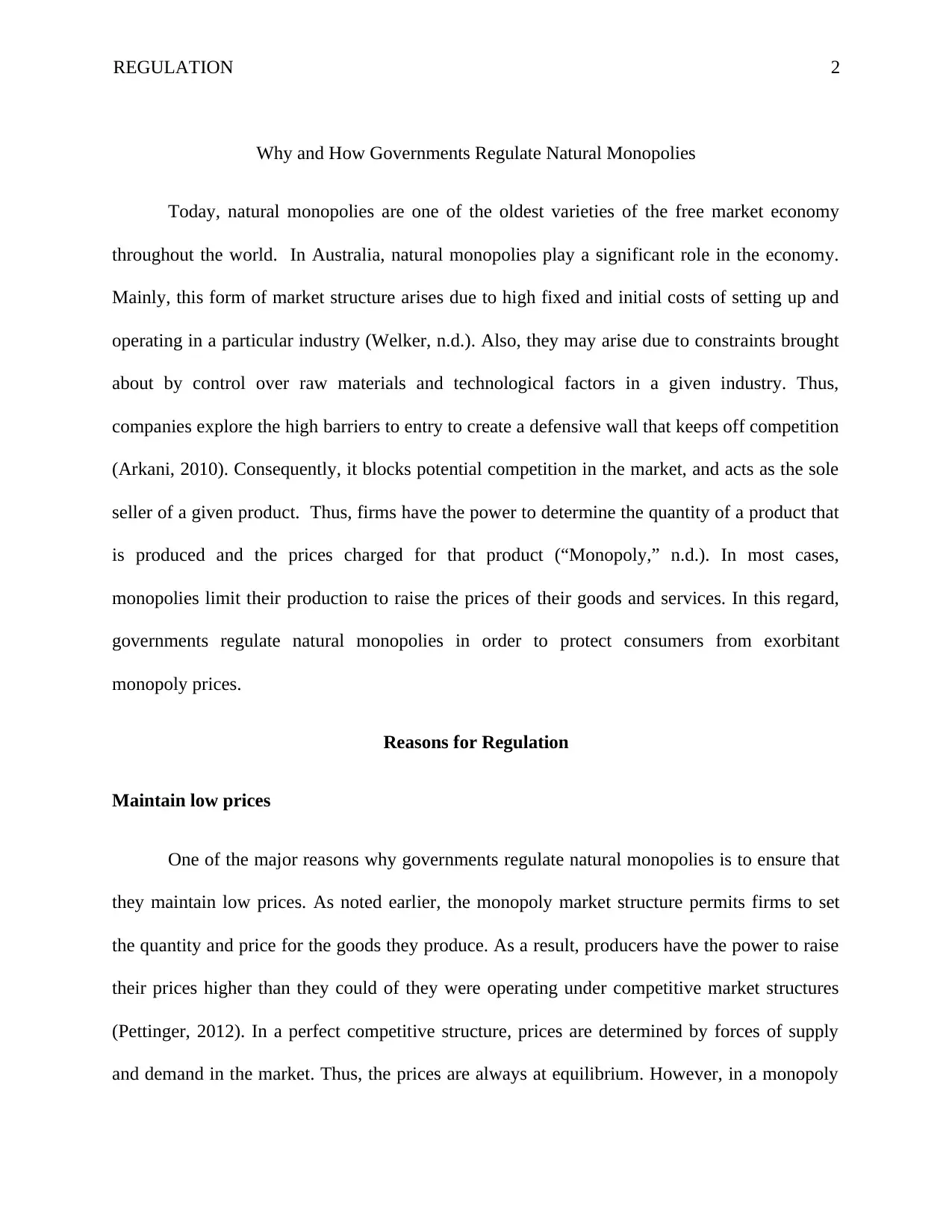
REGULATION 2
Why and How Governments Regulate Natural Monopolies
Today, natural monopolies are one of the oldest varieties of the free market economy
throughout the world. In Australia, natural monopolies play a significant role in the economy.
Mainly, this form of market structure arises due to high fixed and initial costs of setting up and
operating in a particular industry (Welker, n.d.). Also, they may arise due to constraints brought
about by control over raw materials and technological factors in a given industry. Thus,
companies explore the high barriers to entry to create a defensive wall that keeps off competition
(Arkani, 2010). Consequently, it blocks potential competition in the market, and acts as the sole
seller of a given product. Thus, firms have the power to determine the quantity of a product that
is produced and the prices charged for that product (“Monopoly,” n.d.). In most cases,
monopolies limit their production to raise the prices of their goods and services. In this regard,
governments regulate natural monopolies in order to protect consumers from exorbitant
monopoly prices.
Reasons for Regulation
Maintain low prices
One of the major reasons why governments regulate natural monopolies is to ensure that
they maintain low prices. As noted earlier, the monopoly market structure permits firms to set
the quantity and price for the goods they produce. As a result, producers have the power to raise
their prices higher than they could of they were operating under competitive market structures
(Pettinger, 2012). In a perfect competitive structure, prices are determined by forces of supply
and demand in the market. Thus, the prices are always at equilibrium. However, in a monopoly
Why and How Governments Regulate Natural Monopolies
Today, natural monopolies are one of the oldest varieties of the free market economy
throughout the world. In Australia, natural monopolies play a significant role in the economy.
Mainly, this form of market structure arises due to high fixed and initial costs of setting up and
operating in a particular industry (Welker, n.d.). Also, they may arise due to constraints brought
about by control over raw materials and technological factors in a given industry. Thus,
companies explore the high barriers to entry to create a defensive wall that keeps off competition
(Arkani, 2010). Consequently, it blocks potential competition in the market, and acts as the sole
seller of a given product. Thus, firms have the power to determine the quantity of a product that
is produced and the prices charged for that product (“Monopoly,” n.d.). In most cases,
monopolies limit their production to raise the prices of their goods and services. In this regard,
governments regulate natural monopolies in order to protect consumers from exorbitant
monopoly prices.
Reasons for Regulation
Maintain low prices
One of the major reasons why governments regulate natural monopolies is to ensure that
they maintain low prices. As noted earlier, the monopoly market structure permits firms to set
the quantity and price for the goods they produce. As a result, producers have the power to raise
their prices higher than they could of they were operating under competitive market structures
(Pettinger, 2012). In a perfect competitive structure, prices are determined by forces of supply
and demand in the market. Thus, the prices are always at equilibrium. However, in a monopoly
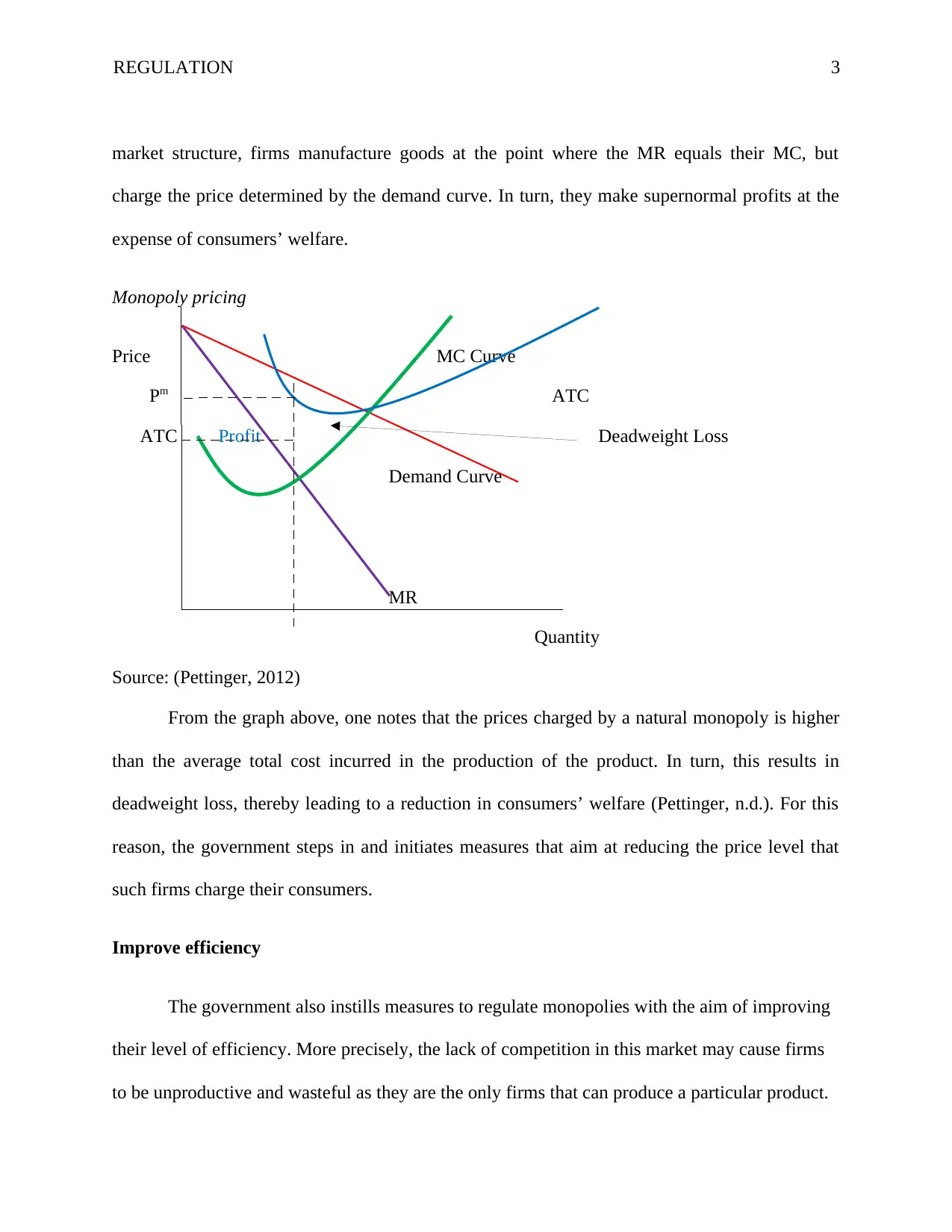
REGULATION 3
market structure, firms manufacture goods at the point where the MR equals their MC, but
charge the price determined by the demand curve. In turn, they make supernormal profits at the
expense of consumers’ welfare.
Monopoly pricing
Price MC Curve
Pm ATC
ATC Profit Deadweight Loss
Demand Curve
MR
Quantity
Source: (Pettinger, 2012)
From the graph above, one notes that the prices charged by a natural monopoly is higher
than the average total cost incurred in the production of the product. In turn, this results in
deadweight loss, thereby leading to a reduction in consumers’ welfare (Pettinger, n.d.). For this
reason, the government steps in and initiates measures that aim at reducing the price level that
such firms charge their consumers.
Improve efficiency
The government also instills measures to regulate monopolies with the aim of improving
their level of efficiency. More precisely, the lack of competition in this market may cause firms
to be unproductive and wasteful as they are the only firms that can produce a particular product.
market structure, firms manufacture goods at the point where the MR equals their MC, but
charge the price determined by the demand curve. In turn, they make supernormal profits at the
expense of consumers’ welfare.
Monopoly pricing
Price MC Curve
Pm ATC
ATC Profit Deadweight Loss
Demand Curve
MR
Quantity
Source: (Pettinger, 2012)
From the graph above, one notes that the prices charged by a natural monopoly is higher
than the average total cost incurred in the production of the product. In turn, this results in
deadweight loss, thereby leading to a reduction in consumers’ welfare (Pettinger, n.d.). For this
reason, the government steps in and initiates measures that aim at reducing the price level that
such firms charge their consumers.
Improve efficiency
The government also instills measures to regulate monopolies with the aim of improving
their level of efficiency. More precisely, the lack of competition in this market may cause firms
to be unproductive and wasteful as they are the only firms that can produce a particular product.
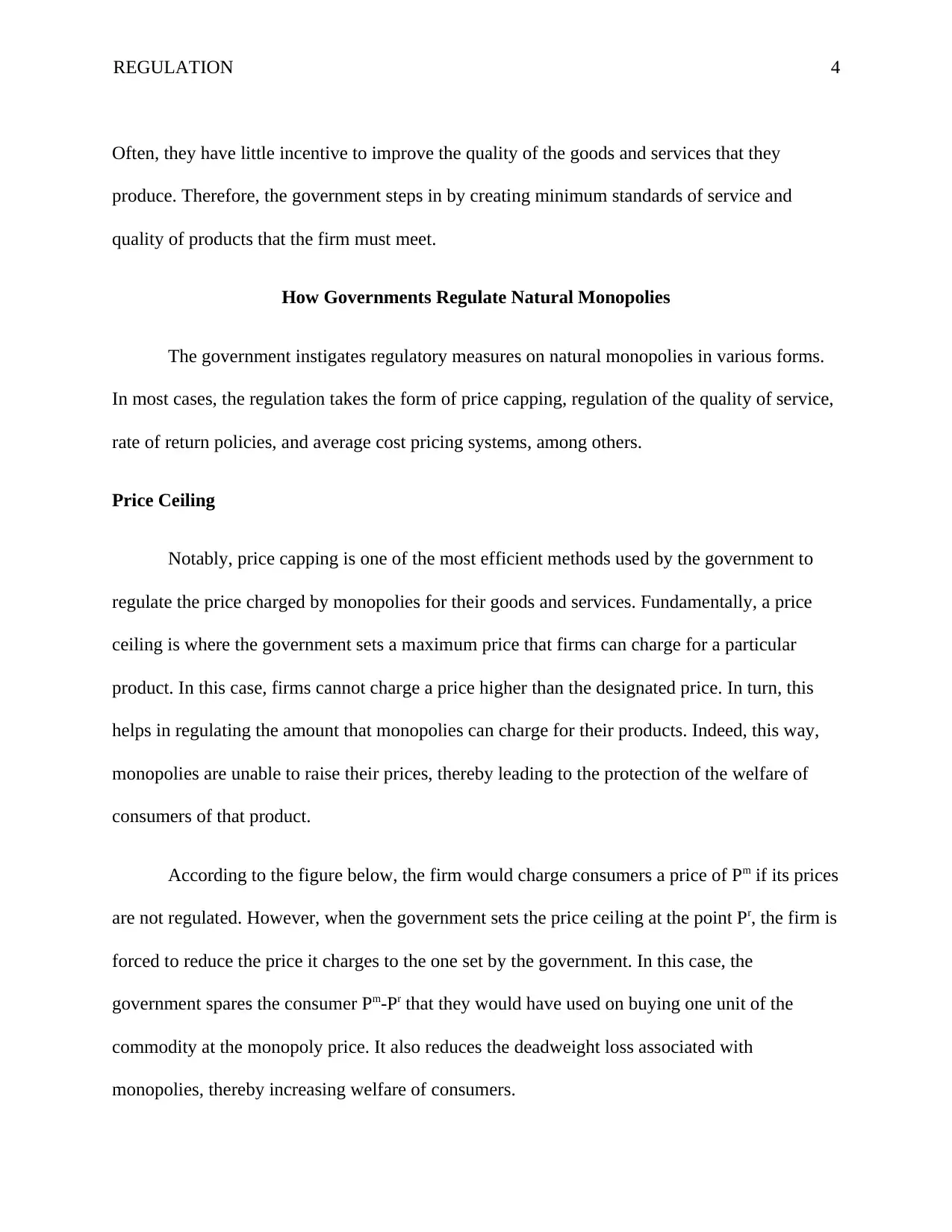
REGULATION 4
Often, they have little incentive to improve the quality of the goods and services that they
produce. Therefore, the government steps in by creating minimum standards of service and
quality of products that the firm must meet.
How Governments Regulate Natural Monopolies
The government instigates regulatory measures on natural monopolies in various forms.
In most cases, the regulation takes the form of price capping, regulation of the quality of service,
rate of return policies, and average cost pricing systems, among others.
Price Ceiling
Notably, price capping is one of the most efficient methods used by the government to
regulate the price charged by monopolies for their goods and services. Fundamentally, a price
ceiling is where the government sets a maximum price that firms can charge for a particular
product. In this case, firms cannot charge a price higher than the designated price. In turn, this
helps in regulating the amount that monopolies can charge for their products. Indeed, this way,
monopolies are unable to raise their prices, thereby leading to the protection of the welfare of
consumers of that product.
According to the figure below, the firm would charge consumers a price of Pm if its prices
are not regulated. However, when the government sets the price ceiling at the point Pr, the firm is
forced to reduce the price it charges to the one set by the government. In this case, the
government spares the consumer Pm-Pr that they would have used on buying one unit of the
commodity at the monopoly price. It also reduces the deadweight loss associated with
monopolies, thereby increasing welfare of consumers.
Often, they have little incentive to improve the quality of the goods and services that they
produce. Therefore, the government steps in by creating minimum standards of service and
quality of products that the firm must meet.
How Governments Regulate Natural Monopolies
The government instigates regulatory measures on natural monopolies in various forms.
In most cases, the regulation takes the form of price capping, regulation of the quality of service,
rate of return policies, and average cost pricing systems, among others.
Price Ceiling
Notably, price capping is one of the most efficient methods used by the government to
regulate the price charged by monopolies for their goods and services. Fundamentally, a price
ceiling is where the government sets a maximum price that firms can charge for a particular
product. In this case, firms cannot charge a price higher than the designated price. In turn, this
helps in regulating the amount that monopolies can charge for their products. Indeed, this way,
monopolies are unable to raise their prices, thereby leading to the protection of the welfare of
consumers of that product.
According to the figure below, the firm would charge consumers a price of Pm if its prices
are not regulated. However, when the government sets the price ceiling at the point Pr, the firm is
forced to reduce the price it charges to the one set by the government. In this case, the
government spares the consumer Pm-Pr that they would have used on buying one unit of the
commodity at the monopoly price. It also reduces the deadweight loss associated with
monopolies, thereby increasing welfare of consumers.
Secure Best Marks with AI Grader
Need help grading? Try our AI Grader for instant feedback on your assignments.
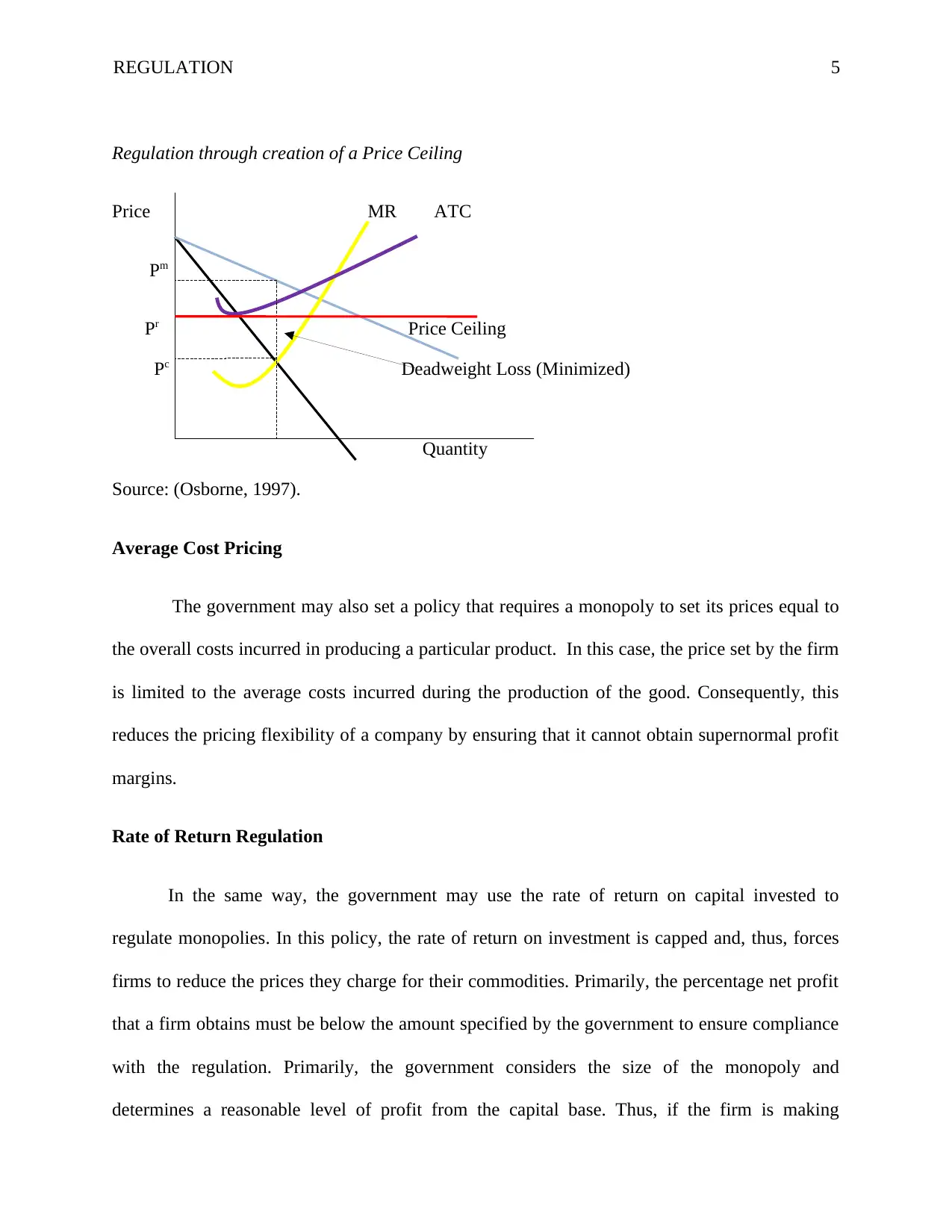
REGULATION 5
Regulation through creation of a Price Ceiling
Price MR ATC
Pm
Pr Price Ceiling
Pc Deadweight Loss (Minimized)
Quantity
Source: (Osborne, 1997).
Average Cost Pricing
The government may also set a policy that requires a monopoly to set its prices equal to
the overall costs incurred in producing a particular product. In this case, the price set by the firm
is limited to the average costs incurred during the production of the good. Consequently, this
reduces the pricing flexibility of a company by ensuring that it cannot obtain supernormal profit
margins.
Rate of Return Regulation
In the same way, the government may use the rate of return on capital invested to
regulate monopolies. In this policy, the rate of return on investment is capped and, thus, forces
firms to reduce the prices they charge for their commodities. Primarily, the percentage net profit
that a firm obtains must be below the amount specified by the government to ensure compliance
with the regulation. Primarily, the government considers the size of the monopoly and
determines a reasonable level of profit from the capital base. Thus, if the firm is making
Regulation through creation of a Price Ceiling
Price MR ATC
Pm
Pr Price Ceiling
Pc Deadweight Loss (Minimized)
Quantity
Source: (Osborne, 1997).
Average Cost Pricing
The government may also set a policy that requires a monopoly to set its prices equal to
the overall costs incurred in producing a particular product. In this case, the price set by the firm
is limited to the average costs incurred during the production of the good. Consequently, this
reduces the pricing flexibility of a company by ensuring that it cannot obtain supernormal profit
margins.
Rate of Return Regulation
In the same way, the government may use the rate of return on capital invested to
regulate monopolies. In this policy, the rate of return on investment is capped and, thus, forces
firms to reduce the prices they charge for their commodities. Primarily, the percentage net profit
that a firm obtains must be below the amount specified by the government to ensure compliance
with the regulation. Primarily, the government considers the size of the monopoly and
determines a reasonable level of profit from the capital base. Thus, if the firm is making
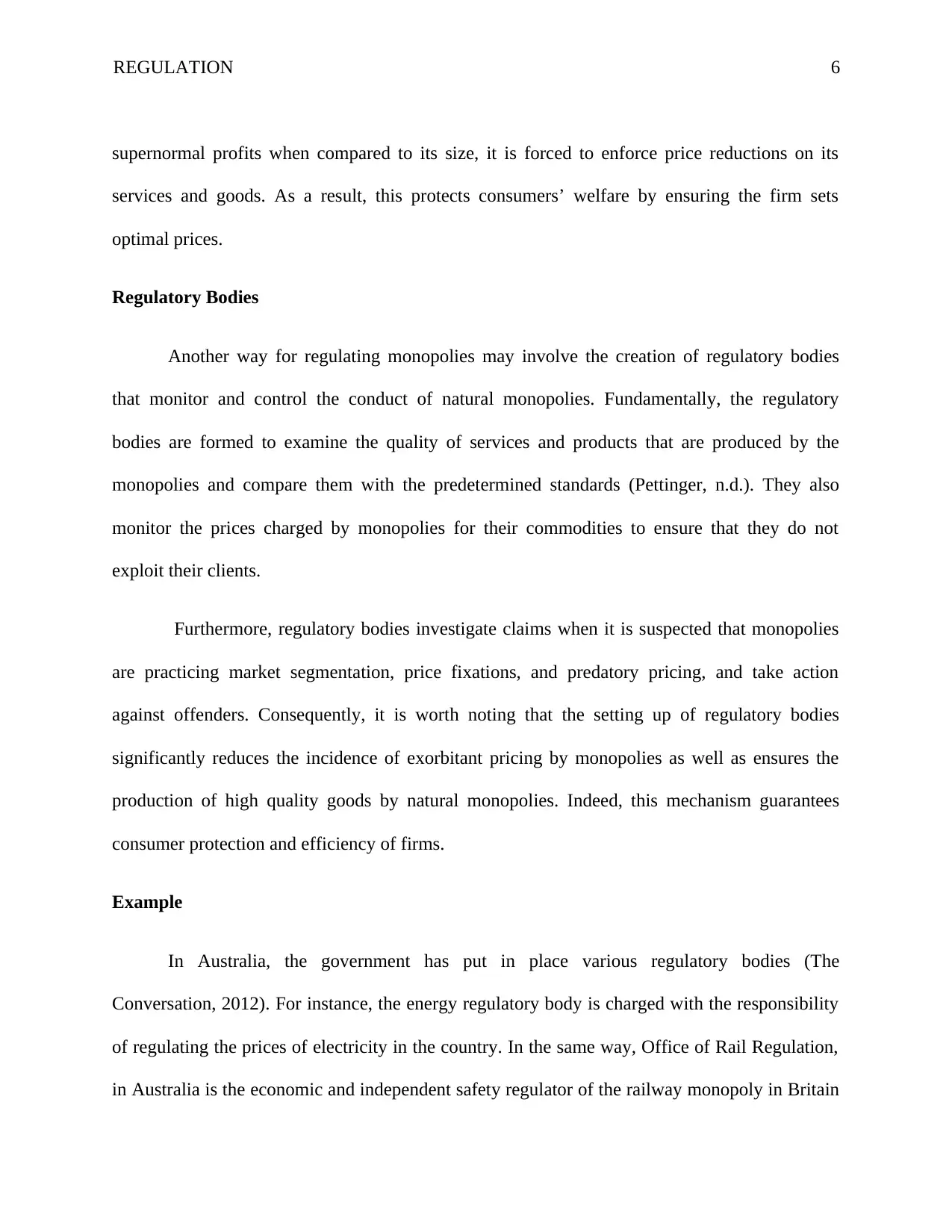
REGULATION 6
supernormal profits when compared to its size, it is forced to enforce price reductions on its
services and goods. As a result, this protects consumers’ welfare by ensuring the firm sets
optimal prices.
Regulatory Bodies
Another way for regulating monopolies may involve the creation of regulatory bodies
that monitor and control the conduct of natural monopolies. Fundamentally, the regulatory
bodies are formed to examine the quality of services and products that are produced by the
monopolies and compare them with the predetermined standards (Pettinger, n.d.). They also
monitor the prices charged by monopolies for their commodities to ensure that they do not
exploit their clients.
Furthermore, regulatory bodies investigate claims when it is suspected that monopolies
are practicing market segmentation, price fixations, and predatory pricing, and take action
against offenders. Consequently, it is worth noting that the setting up of regulatory bodies
significantly reduces the incidence of exorbitant pricing by monopolies as well as ensures the
production of high quality goods by natural monopolies. Indeed, this mechanism guarantees
consumer protection and efficiency of firms.
Example
In Australia, the government has put in place various regulatory bodies (The
Conversation, 2012). For instance, the energy regulatory body is charged with the responsibility
of regulating the prices of electricity in the country. In the same way, Office of Rail Regulation,
in Australia is the economic and independent safety regulator of the railway monopoly in Britain
supernormal profits when compared to its size, it is forced to enforce price reductions on its
services and goods. As a result, this protects consumers’ welfare by ensuring the firm sets
optimal prices.
Regulatory Bodies
Another way for regulating monopolies may involve the creation of regulatory bodies
that monitor and control the conduct of natural monopolies. Fundamentally, the regulatory
bodies are formed to examine the quality of services and products that are produced by the
monopolies and compare them with the predetermined standards (Pettinger, n.d.). They also
monitor the prices charged by monopolies for their commodities to ensure that they do not
exploit their clients.
Furthermore, regulatory bodies investigate claims when it is suspected that monopolies
are practicing market segmentation, price fixations, and predatory pricing, and take action
against offenders. Consequently, it is worth noting that the setting up of regulatory bodies
significantly reduces the incidence of exorbitant pricing by monopolies as well as ensures the
production of high quality goods by natural monopolies. Indeed, this mechanism guarantees
consumer protection and efficiency of firms.
Example
In Australia, the government has put in place various regulatory bodies (The
Conversation, 2012). For instance, the energy regulatory body is charged with the responsibility
of regulating the prices of electricity in the country. In the same way, Office of Rail Regulation,
in Australia is the economic and independent safety regulator of the railway monopoly in Britain
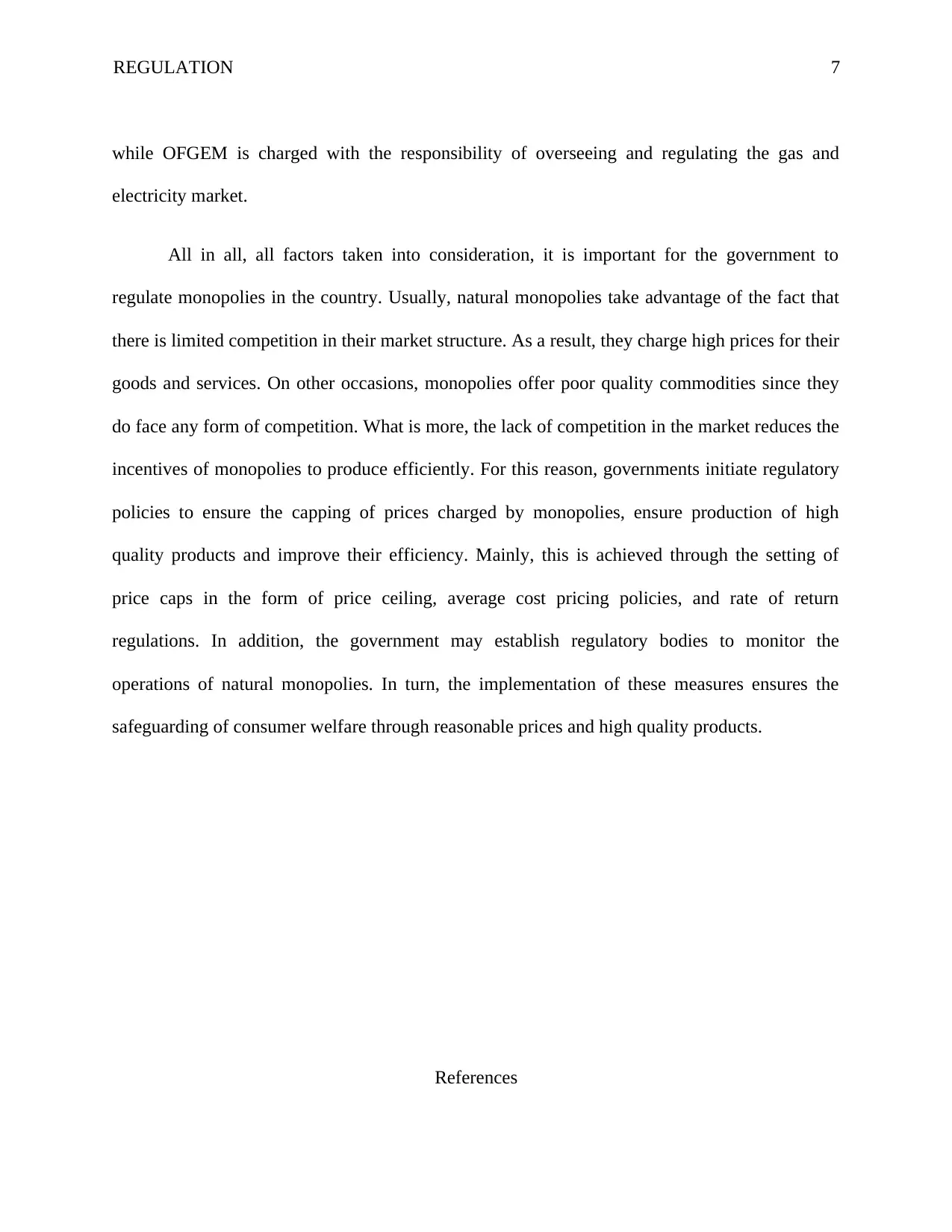
REGULATION 7
while OFGEM is charged with the responsibility of overseeing and regulating the gas and
electricity market.
All in all, all factors taken into consideration, it is important for the government to
regulate monopolies in the country. Usually, natural monopolies take advantage of the fact that
there is limited competition in their market structure. As a result, they charge high prices for their
goods and services. On other occasions, monopolies offer poor quality commodities since they
do face any form of competition. What is more, the lack of competition in the market reduces the
incentives of monopolies to produce efficiently. For this reason, governments initiate regulatory
policies to ensure the capping of prices charged by monopolies, ensure production of high
quality products and improve their efficiency. Mainly, this is achieved through the setting of
price caps in the form of price ceiling, average cost pricing policies, and rate of return
regulations. In addition, the government may establish regulatory bodies to monitor the
operations of natural monopolies. In turn, the implementation of these measures ensures the
safeguarding of consumer welfare through reasonable prices and high quality products.
References
while OFGEM is charged with the responsibility of overseeing and regulating the gas and
electricity market.
All in all, all factors taken into consideration, it is important for the government to
regulate monopolies in the country. Usually, natural monopolies take advantage of the fact that
there is limited competition in their market structure. As a result, they charge high prices for their
goods and services. On other occasions, monopolies offer poor quality commodities since they
do face any form of competition. What is more, the lack of competition in the market reduces the
incentives of monopolies to produce efficiently. For this reason, governments initiate regulatory
policies to ensure the capping of prices charged by monopolies, ensure production of high
quality products and improve their efficiency. Mainly, this is achieved through the setting of
price caps in the form of price ceiling, average cost pricing policies, and rate of return
regulations. In addition, the government may establish regulatory bodies to monitor the
operations of natural monopolies. In turn, the implementation of these measures ensures the
safeguarding of consumer welfare through reasonable prices and high quality products.
References
Paraphrase This Document
Need a fresh take? Get an instant paraphrase of this document with our AI Paraphraser
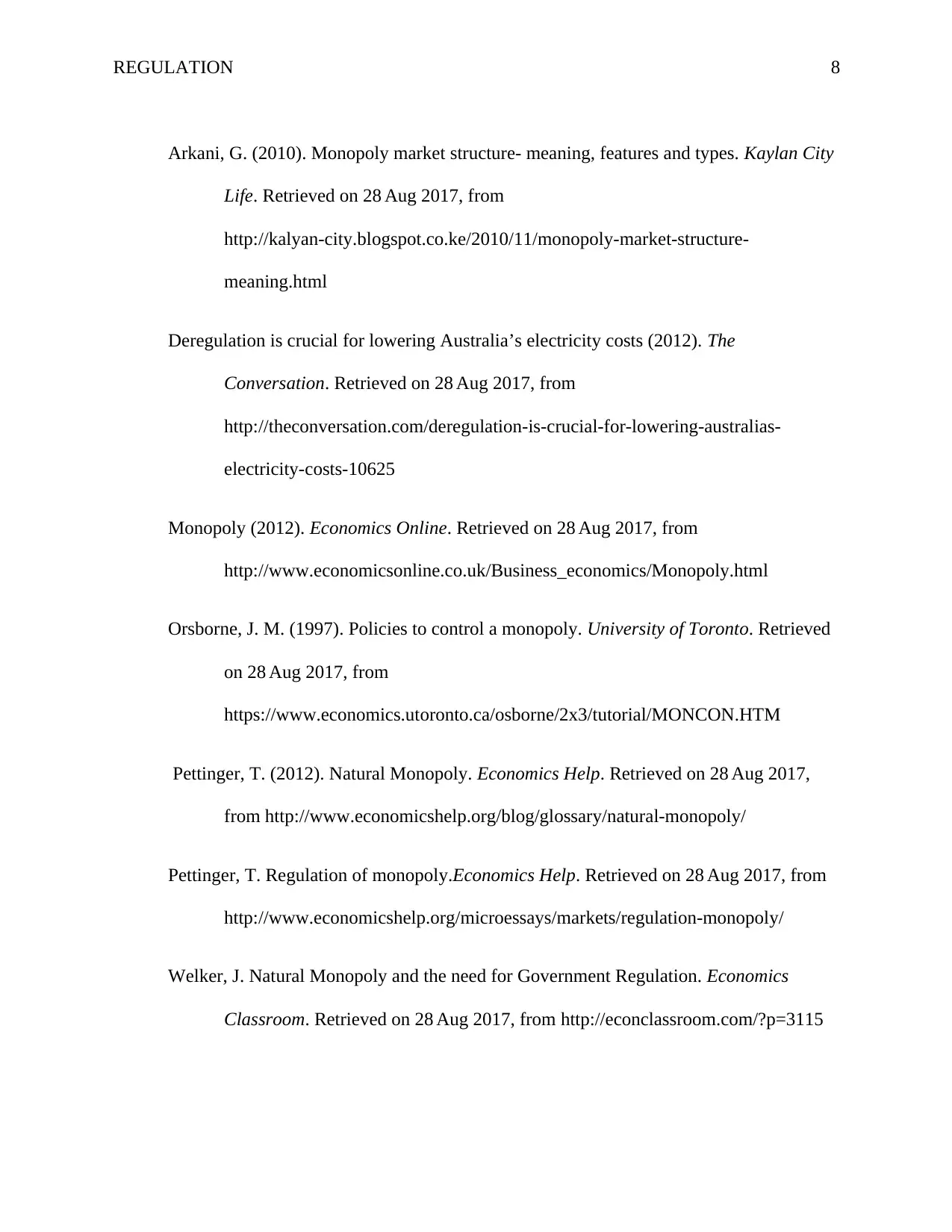
REGULATION 8
Arkani, G. (2010). Monopoly market structure- meaning, features and types. Kaylan City
Life. Retrieved on 28 Aug 2017, from
http://kalyan-city.blogspot.co.ke/2010/11/monopoly-market-structure-
meaning.html
Deregulation is crucial for lowering Australia’s electricity costs (2012). The
Conversation. Retrieved on 28 Aug 2017, from
http://theconversation.com/deregulation-is-crucial-for-lowering-australias-
electricity-costs-10625
Monopoly (2012). Economics Online. Retrieved on 28 Aug 2017, from
http://www.economicsonline.co.uk/Business_economics/Monopoly.html
Orsborne, J. M. (1997). Policies to control a monopoly. University of Toronto. Retrieved
on 28 Aug 2017, from
https://www.economics.utoronto.ca/osborne/2x3/tutorial/MONCON.HTM
Pettinger, T. (2012). Natural Monopoly. Economics Help. Retrieved on 28 Aug 2017,
from http://www.economicshelp.org/blog/glossary/natural-monopoly/
Pettinger, T. Regulation of monopoly.Economics Help. Retrieved on 28 Aug 2017, from
http://www.economicshelp.org/microessays/markets/regulation-monopoly/
Welker, J. Natural Monopoly and the need for Government Regulation. Economics
Classroom. Retrieved on 28 Aug 2017, from http://econclassroom.com/?p=3115
Arkani, G. (2010). Monopoly market structure- meaning, features and types. Kaylan City
Life. Retrieved on 28 Aug 2017, from
http://kalyan-city.blogspot.co.ke/2010/11/monopoly-market-structure-
meaning.html
Deregulation is crucial for lowering Australia’s electricity costs (2012). The
Conversation. Retrieved on 28 Aug 2017, from
http://theconversation.com/deregulation-is-crucial-for-lowering-australias-
electricity-costs-10625
Monopoly (2012). Economics Online. Retrieved on 28 Aug 2017, from
http://www.economicsonline.co.uk/Business_economics/Monopoly.html
Orsborne, J. M. (1997). Policies to control a monopoly. University of Toronto. Retrieved
on 28 Aug 2017, from
https://www.economics.utoronto.ca/osborne/2x3/tutorial/MONCON.HTM
Pettinger, T. (2012). Natural Monopoly. Economics Help. Retrieved on 28 Aug 2017,
from http://www.economicshelp.org/blog/glossary/natural-monopoly/
Pettinger, T. Regulation of monopoly.Economics Help. Retrieved on 28 Aug 2017, from
http://www.economicshelp.org/microessays/markets/regulation-monopoly/
Welker, J. Natural Monopoly and the need for Government Regulation. Economics
Classroom. Retrieved on 28 Aug 2017, from http://econclassroom.com/?p=3115
1 out of 8
Related Documents
Your All-in-One AI-Powered Toolkit for Academic Success.
+13062052269
info@desklib.com
Available 24*7 on WhatsApp / Email
![[object Object]](/_next/static/media/star-bottom.7253800d.svg)
Unlock your academic potential
© 2024 | Zucol Services PVT LTD | All rights reserved.





